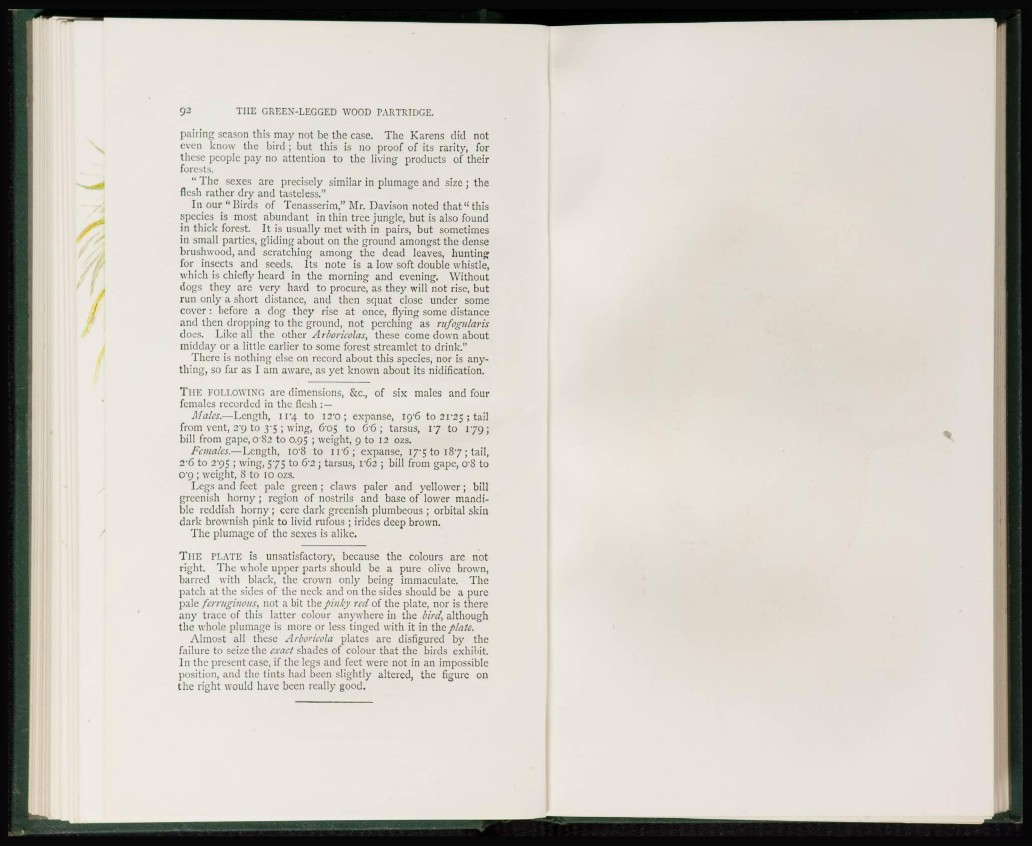
paii ing season tin's may not be the case. The Karens did not
even know the bird ; but this is no proof of its rarity, for
these people pay no attention to the living products of their
forests.
" The sexes are precisely similar in plumage and size ; the
flesh rather dry and tasteless."
In our "Birds of Tcnasserim," Mr. Davison noted that"this
species is most abundant in thin tree jungle, but is also found
in thick forest. It is usually met with in pairs, but sometimes
in small parties, gliding about on the ground amongst the dense
brushwood, and scratching among the dead leaves, hunting
for insects and seeds. Its note is a low soft double whistle,
which is chiefly heard in the morning and evening. Without
dogs they are very hard to procure, as they will not rise, but
run only a short distance, and then squat close under some
cover : before a dog they rise at once, flying some distance
and then dropping to the ground, not perching as rufogularis
does. Like all the other Arboricolas, these come down about
midday or a little earlier to some forest streamlet to drink."
There is nothing else on record about this species, nor is anything,
so far as I am aware, as yet known about its nidification.
T H E FOLLOWING arc dimensions, &c, of six males and four
females recorded in the flesh : —
Males.—Length, 11*4 to I2'0; expanse, 196 to 2 T 2 5 ; tail
from vent, 2'9 to 3'5 ; wing, 6'05 to 66 ; tarsus, 17 to 1 7 9 ;
bill from gape, o 82 to 0.95 ; weight, 9 to 12 ozs.
Females.—Length, I0'8 to i r 6 ; expanse, 17-5 to 187 ; tail,
2'6 to 2'95 ; wing, 575 to 6'2 ; tarsus, r62 ; bill from gape, 08 to
C 9 ; weight, 8 to 10 ozs.
Legs and feet pale green ; claws paler and yellower; bill
greenish horny ; region of nostrils and base of lower mandible
reddish horny; cere dark greenish plumbeous ; orbital skin
dark brownish pink to livid rufous ; irides deep brown.
The plumage of the sexes is alike.
T H E PLATE is unsatisfactory, because the colours are not
right. The whole upper parts should be a pure olive brown,
barred with black, the crown only being immaculate. The
patch at the sides of the neck and on the sides should be a pure
pale ferruginous, not a bit the pinky red of the plate, nor is there
any trace of this latter colour anywhere in the bird, although
the whole plumage is more or less tinged with it in the plate.
Almost all these Arboricola plates are disfigured by the
failure to seize the exact shades of colour that the birds exhibit.
In the present case, if the legs and feet were not in an impossible
position, and the tints had been slightly altered, the figure on
the right would have been really good.